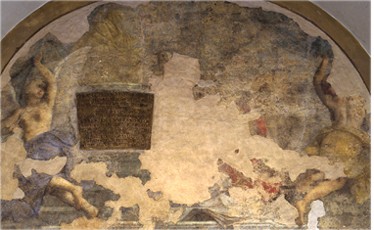The upper arcaded loggia: the painted "memoires"
On the first floor of the building there are the Library and the historical rooms, the Anatomical Theater and the Stabat Mater room, as well as numerous coats of arms and memorials.

The memorial dedicated to the physician Giovanni Girolamo Sbaraglia, by Donato Creti (1671 - 1749) and Giuseppe Mazza (1652 - 1741).
Sbaraglia held the chair of Anatomy and Medicine for forty years and died in 1710, at the age of 69. His testamentary dispositions were important for the city, as they linked his heritage to the creation of a public library, but his heir Marco Antonio Collina did not succeed in realizing it, so he donated G. G. Sbaraglia's books to the library of the Jesuits of Saint Lucia and to the library of the Institute of Sciences. The bronze portrait of Sbaraglia results from the medal made by Ferdinand de Saint-Urbain, and the portrait was realised by Giuseppe Maria Mazza on a drawing by Creti, who also made an engraving. The painting was realised in oils on the wall surface in 1713 by Donato Creti but, as early as 1717, the painter wrote a letter explaining that the painting had been ruined by the lime, because it was made on a wall that was still wet. In this work Creti uses a palette of a great chromatic refinement, with the characteristic ultramarine blue colour. Two allegorical figures, Experience (which has the eyes drawn on the palms of the hands) and Reason (that holds a horse bit, alluding to the ability to tame passions) show the medallion above, with Sbaraglia's effigy, to the viewer. The figures are elegant as porcelain statues and, in their faces, they take the guise of the painter and of his beautiful wife. Their profiles are like engraves on cameos and embellished by the teardrop earring frequently used by the painter. As in religious paintings, the double human and celestial level is reproduced here, to which the scenic artifice of the curtain which opens like in a theatre is added. The brushstrokes are fluid, antithetical to Giuseppe Maria Crespi's full-bodied and direct painting of touch. Crespi was the other great interpreter of the Bolognese painting of the eighteenth century.
The allegory dedicated to Marcello Malpighi, by Marcantonio Franceschini (1648 - 1729)
The painter was a faithful and archaic follower of Carlo Cignani and, generally, of the Bolognese academicism. In this fresco (1683 - 1687), the painter has expressed his classicist culture: almost in an unholy liturgy, in this work we can observe Mercury, the symbol of eloquence and reason, that is on the top of an altar and that entrusts a sheet of paper with the name of the well-known Bolognese physician and biologist Marcello Malpighi (1628 - 1694) to Eternity. On the right, Medicine attends the scene while holding a caduceus. The figures are placed in a sort of chapel with an apse composed of decorated ribs, on whose background there are some putti that fly with laurel wreaths.
Muratori's memorial
The only monument that was made by a female artist is Muratori's memorial, which is located on the southern wall of the upper arcade. It was heavily damaged by the bombing of the 29th January 1944 and, also, by the subsequent restoration, because of a tear of the pictorial surface. The memorial was painted in 1707 by Teresa Muratori and it was commissioned by her father Roberto to renew an older monument in honour of the ancestors, the two philosophers and physicians Francesco and Achille Muratori. We can see the Fame on the left side and Mercury on the right side that lift the draperies on a scene that is dominated by the figure of Aesculapius at the top.
The memorial dedicated to the physician Antonio Valsalva, by Angelo Piò (1690 - 1770) and anonymous fresco painter.
The sculpted marble portrait is austere and solemn, if we compare it to the usual style of the artist, a fine interpreter of the Bolognese Baroque style; on this occasion, he evidently wanted to adapt his style to the elegance of the location. The profile portrait with a large wig recalls an analogous oval stucco medallion made by the artist in the Church of San Domenico to commemorate the general Luigi Ferdinando Marsigli, the founder of the Institute of Sciences.

di Angelo Piò (1690 - 1770) e anonimo frescante

di Teresa Muratori , 1707

di Teresa Muratori , 1707

